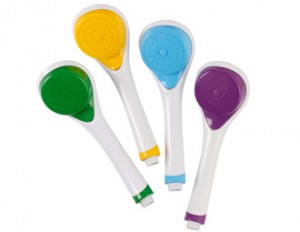For the visually impaired or older patients, seeing their white showerhead against the white tiled background of a shower cubicle is almost impossible as the lack of contrast makes the showerhead almost invisible to the visually impaired patient
BS8300 is a British Standard that sets out how buildings should be designed, constructed and maintained to create an accessible and inclusive environment for disabled people.
BS8300 is in place to ensure that everyone can use a built environment equally. Everybody – particularly the disabled, elderly or those less able to stand – should be able to enter, use and exit a building easily, comfortably and independently.
After consultation with the RNIB (Royal National Institute for the Blind) Challis Ag+ redesigned our shower head with bold, full coloured shower faces that creates a bold colour contrast, making the Challis Ag+ showerhead much more easily seen and identified by the visually impaired. Something as simple as bracketing the handle of the showerhead with bold contrasting colours can also make it quick and easy to identify where the handle of the shower head actually is so it can be easily grasped and directed.
Many manufacturers compromise by putting a small coloured pip or thin colored trim on the showerhead which is designed for auditing purposes only and can best be regarded as an inadequate compromise, not a solution.

Many modern designed showerheads may look great but to the visually impaired patient, these funky designs make it difficult to determine something as basic as which way round the showerhead is pointing.
A shower head needs to feel like a showerhead with the face, handle and direction easily identified by touch. Challis Ag+ looks and more importantly feels like a proper showerhead so the patient knows which way the shower is pointing and gets no frightening shocks or a blast of water from an unexpected direction.
The Challis Ag+ Showers is the only manufacturer that include bold contrasting colours combined with easily grip-able shape and definitive feel specifically designed for inclusive use by the less abled and visually impaired patients.
If you have a policy of full inclusion of all types of disability then please don’t forget the visually impaired patients and their needs.

